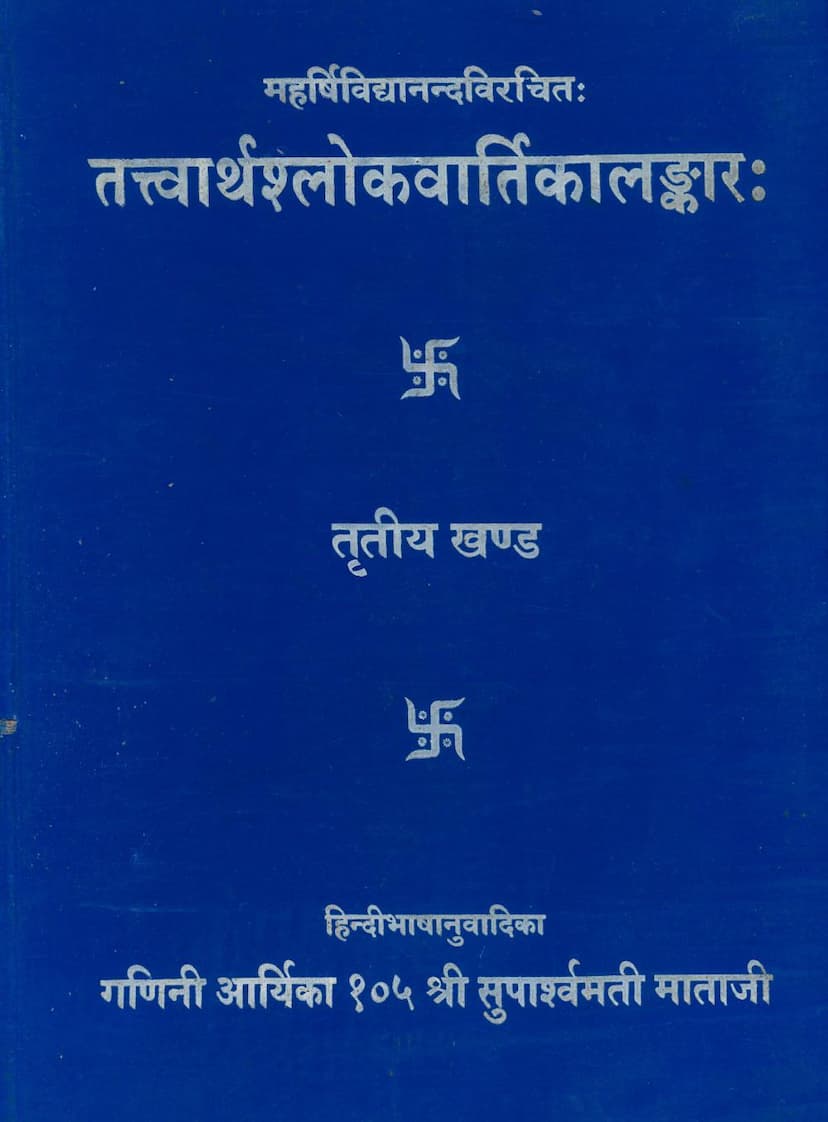Tattvarthashloakvartikalankar Part 03
Added to library: September 2, 2025

Summary
Here is a comprehensive summary of the Jain text "Tattvarthashloakvartikalankar Part 03" by Suparshvamati Mataji, based on the provided pages:
This volume, the third part of "Tattvarthashloakvartikalankar," is a Hindi translation and commentary on the original Sanskrit work by Maharshi Vidyananda, with the Hindi translation and explanation meticulously done by Ganini Aryika 105 Shri Suparshvamati Mataji. The work is dedicated to the spiritual lineage, honoring Acharya Shri Virsagar Ji Maharaj and Aryika Shri Indumati Mataji.
Core Content and Scope:
This volume primarily focuses on the intricate exposition of Mati (sensory) knowledge and Shrut (scriptural) knowledge within the Tattvarthasutra, as detailed by the Vartikakar (commentator) Maharshi Vidyananda. The commentary covers Sutras 9 through 20, which fall under the Tritiya Ahnik (Third Chapter) of the Tattvarthasutra.
Key Philosophical and Logical Arguments Explored:
The text delves into several complex philosophical and logical debates, refuting the views of various other schools of thought to establish the Jain perspective:
- Nature of Knowledge (Sutra 9): Maharshi Vidyananda elucidates the classification of knowledge, refuting the theories of Mimamsakas (who consider all knowledge as indirect), Naiyayikas (who believe knowledge is known through other knowledge), and Sankhyas (who consider knowledge as unconscious). The text emphasizes the inherent validity and self-luminosity of knowledge, particularly within its own essence. The explanation of different types of knowledge (Mati, Shrut, Avadhi, Manahparyaya, Keval) is presented with detailed arguments and refutations of opposing views.
- Pramana (Means of Valid Knowledge) (Sutra 10): A significant portion of the text is dedicated to defining and establishing the nature of Pramana. It refutes the idea that sensory organs (indriyas) themselves are Pramana, arguing that it is the knowledge itself that constitutes Pramana. The text discusses the relationship between Pramana, Pramata (knower), and Prameya (known), asserting their inseparable yet distinct nature. It also meticulously dissects and refutes various theories on the origination of knowledge, including those that rely solely on sensory contact (sannikarsa) or other external factors. The concept of "Avayavachari" (non-erroneous) and "Vyabhichari" (erroneous) knowledge is extensively debated.
- Distinction between Pratyaksha and Paroksha (Sutras 11-12): The text clarifies the definitions of direct (Pratyaksha) and indirect (Paroksha) knowledge, firmly establishing Mati and Shrut as Paroksha, while Avadhi, Manahparyaya, and Keval are Pratyaksha. It engages in detailed etymological and logical analysis to support these classifications and to refute alternative interpretations.
- Detailed Analysis of Mati-Shruta Knowledge (Sutras 13-20):
- Mati-Kala (Mati Knowledge) (Sutras 13-16): The commentary provides an exhaustive analysis of Mati-jnana, including its causes (nimitta karanas), its various sub-types (Smriti, Pratyabhigyaana, Sangya, Chinta), and their specific characteristics. It meticulously refutes the claims of other philosophers who deny the validity or distinctness of these internal cognitive processes. The text details how these different stages of sensory cognition arise from the interplay of sensory organs, mind, and the object of knowledge.
- Shabda (Shruta Knowledge) (Sutra 20): The discussion extends to Shrut-jnana, its authenticity, and its various classifications. The importance of scriptural knowledge as a source of understanding subtle realities is highlighted.
Methodology and Style:
Maharshi Vidyananda's original work is known for its depth and rigorous logical arguments. Suparshvamati Mataji's translation and commentary aim to retain this profundity while making the complex subjects accessible to Hindi-speaking readers. She provides a "Mulanugami" (root-following) translation, meaning it closely adheres to the original meaning and intent of the Vartikakar, avoiding extensive independent elaborations. The commentary includes detailed discussions on various philosophical viewpoints and their refutations, demonstrating the author's profound understanding of Jain philosophy and logic.
Overall Significance:
This volume is crucial for understanding the nuances of perception and scriptural knowledge in Jainism. It showcases the Jain philosophy's sophisticated epistemological framework, which distinguishes between different types and sources of knowledge, and emphasizes the role of subtle reasoning in discerning reality. The text serves as a valuable resource for advanced Jain scholars and seekers of spiritual knowledge. The extensive number of Vartikas (over 1066) used in this volume underscores the depth of the analysis.